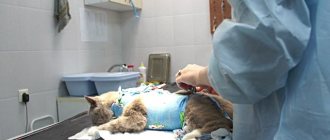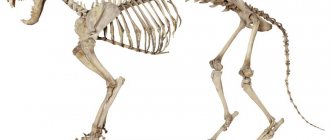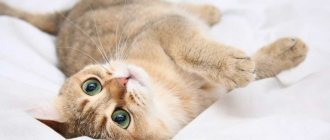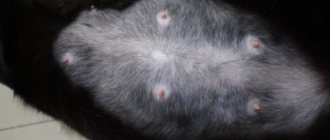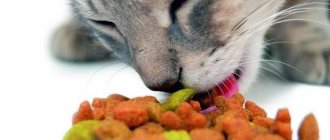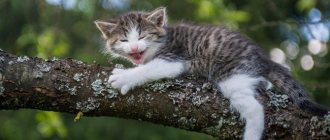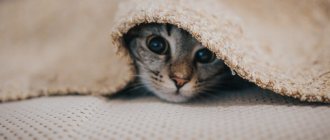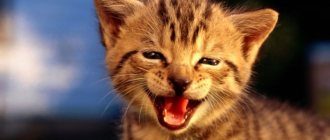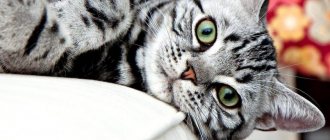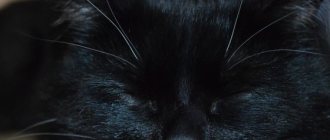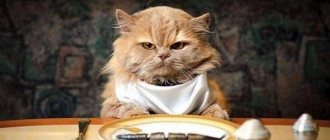Cats... Many people's pets. Some people like red ones, some like black ones, some like mosaic ones. Others are attracted to Persians, Siamese cats or Egyptian cats. It's all a matter of taste.
However, the color of an animal, its exterior, character, diseases, pathologies, mutations depend not only on the breed or lifestyle, but also on the chromosome set (primarily on it), which is constant and definite.
And yet, how many chromosomes does a cat have, what are their numbers and functions? This will be discussed below.
Genome and chromosomes
It is extremely difficult to talk about how many chromosomes a cat has without basic knowledge of genetics.
A genome is a structure that contains the genetic information of an organism. Almost every cell contains a genome. But the chromosome contains all the information about the structure of the cell. A chromosome is a nucleoprotein structure in the nucleus of a eukaryotic cell. The chromosome contains a significant part of hereditary information, which is stored, implemented and transmitted to the future generation.
A chromosome is a structure in the cell nucleus made up of deoxyribonucleic acid (DNA) and proteins. It is worth recalling that DNA is a macromolecule that ensures storage, transmission from generation to generation, and the implementation of the genetic program for the development of a living organism.
There are two types of chromosomes in different organisms:
Eukaryotic type - characteristic of living organisms (eukaryotes), whose cells contain a nuclear membrane, DNA molecules in the nucleus and mitochondria.
Prokaryotic type - found in organisms whose cells lack a nuclear envelope, and DNA molecules are enclosed in histones (prokaryotes).
Externally, a chromosome looks like a long thread with stringed beads, each of which is a gene. In addition, the gene is located on its strictly fixed part of the chromosome - the locus.
The work of breeders
Knowing the structure of the apparatus that stores information about the body, as well as the laws of inheritance of genes and the characteristics of their manifestation, breeders develop new varieties of plants.
Wild wheat often has a diploid set of chromosomes. There are not many wild representatives that are tetraploid. Cultivated varieties more often contain tetraploid and even hexaploid sets of structures in their somatic cells. This improves yield, weather resistance, and grain quality.
Genetics is an interesting science. The structure of the apparatus, which contains information about the structure of the entire organism, is similar in all living beings. However, each type of creature has its own genetic characteristics. One of the characteristics of a species is the number of chromosomes. Organisms of the same species always have a certain constant number of them.
Number of chromosomes in animals
How many chromosomes are there in cat cells? Any living organism has homologous or paired chromosomes and haploid or unpaired (sex) chromosomes. The latter include the egg and sperm; they have a set of XX and XY, respectively. When dividing, they break up into X, X and X, Y. Depending on the new combination of the pair in the fertilized cell, the sex of the new organism (in our case, a kitten) will be determined.
To the question: “How many chromosomes are there in cat cells?”, genetics gives an exact answer. In a domestic cat, the chromosome set includes 19 pairs of chromosomes (18 paired and 1 unpaired: XX in females and XY in males). The total number of chromosomes in a cat is 38.
In other animals, the number of chromosomes is constant and individual for each species (for example, dogs have 78 chromosomes, horses have 64, cows have 60, and hare has 48). Recall that humans have 46 chromosomes.
Karyotype and chromosome complex of a cat
A karyotype is a paired set of chromosomes with a specific number, size and shape for each animal species. The characteristics of each type of living organism are inherited by karyotype. For example, a karyotypic feature may be the presence of a trunk in elephants. The birth of a baby elephant without a trunk will be a deviation from the karyotypic norm, that is, a pathology.
All cells are paired, the future appearance, appearance, color, and character of the cat depend on them. The last - 19 pair contains sexual information and half of the chromosome set. During the process of fertilization, both parts join together to form a complete cell.
Features of the karyotype of some breeds
From school biology textbooks, everyone has become familiar with the term chromosome. The concept was proposed by Waldeyer in 1888. It literally translates as painted body. The first object of research was the fruit fly.
A chromosome is a structure in the cell nucleus that stores hereditary information. They are formed from a DNA molecule that contains many genes. In other words, a chromosome is a DNA molecule.
Its amount varies among different animals. So, for example, a cat has 38, and a cow has 120. Interestingly, earthworms and ants have the smallest numbers.
Their number is two chromosomes, and the male of the latter has one.
chromosome xy and xx
In higher animals, as well as in humans, the last pair is represented by XY sex chromosomes in males and XX in females.
For example, we can consider the content of chromosomes in some organisms: chimpanzees - 48, crayfish - 196, wolves - 78, hare - 48. This is due to the different level of organization of a particular animal.
You need to pay attention! In monkeys, the number of chromosomes is close to that of humans. But the results are different for each species. So, different monkeys have the following number of chromosomes:
- Lemurs have 44-46 DNA molecules in their arsenal;
- Chimpanzees – 48;
- Baboons – 42,
- Monkeys – 54;
- Gibbons – 44;
- Gorillas – 48;
- Orangutan – 48;
- Macaques - 42.
The canine family (carnivorous mammals) has more chromosomes than monkeys.
- So, the wolf has 78,
- the coyote has 78,
- the small fox has 76,
- but the ordinary one has 34.
- The predatory animals lion and tiger have 38 chromosomes.
- The cat's pet has 38, while his dog opponent has almost twice as many - 78.
In mammals that are of economic importance, the number of these molecules is as follows:
- rabbit – 44,
- cow – 60,
- horse – 64,
- pig – 38.
Informative! Hamsters have the largest chromosome sets among animals. They have 92 in their arsenal. Also in this row are hedgehogs. They have 88-90 chromosomes. And kangaroos have the smallest amount of these molecules. Their number is 12. A very interesting fact is that the mammoth has 58 chromosomes. Samples were taken from frozen tissue.
For greater clarity and convenience, data from other animals will be presented in the summary.
1. Common lemur 44-60 2. Woolly monkey 62 3. Baboons 42 4. Wolf (red, red, maned) 78 5. Dingo 78 6. Corsac fox (steppe fox) 36 7. American fox 50 8. Coyote 78 9. Small fox 76 10. Gray fox 66 11. Tibetan fox 36 12. Paraguayan fox 74 13. Arctic fox 48-50 14. Dog 78 15. Common jackal 78 16.
Striped skunk 50
53. Turkey 82
As you can see, each animal has a different number of chromosomes. Even among representatives of the same family, indicators differ. We can look at the example of primates:
- the gorilla has 48,
- the macaque has 42, and the marmoset has 54 chromosomes.
Why this is so remains a mystery.
Every living organism (the only exception is bacteria) has chromosomes. They are located in every cell of the body in a certain amount. In all somatic cells, chromosomes are repeated twice, three times, or more times, depending on the type of animal or variety of plant organism.
In germ cells, the chromosome set is haploid, that is, single. This is necessary so that when two germ cells merge, the correct set of genes for the body is restored. However, the haploid set of chromosomes also contains genes responsible for the organization of the entire organism. Some of them may not appear in the offspring if the second reproductive cell contains stronger characteristics.
There are groups of genes that have been studied by science. Their location and properties are known.
According to their effect on the body, they are divided into:
- Body shape genes;
- Genes for coat length and texture;
- Coat pattern and color.
Color genes are also divided into 3 groups:
- Color genes – genes responsible for the density and shade of fur;
- Pattern genes - color brightness and pattern;
- Genes responsible for masks that can appear in a cat's color.
Body shape genes - form important external characteristics, such as paws, ears, tail. Below are some of them:
- Normal Ears/Scottish Fold Ears;
- Extra Toes/Regular Paws;
- Manx – no tail at all/Broken tail/Regular tail.
Coat genes are responsible for the texture and length of the coat:
- Sphinx genes - a recessive mutation leads to the hairlessness of sphinxes, while the normal allele dominates and forms normal hair in cats.
- Genes for long hair - formed as a result of a recessive mutation, which made it possible to obtain breeds such as Siberian, Angora, Persian.
Genes for color or coat color have three subgroups:
- Genes for black coat color have a total of 3 alleles, but in addition to them they also have an allele for albinism.
- The genes for red color have 2 alleles: color and complete absence of orange.
In this article, we examined the main points and concepts of cat genetics, mainly related to appearance. The main thing to remember is that everything is not as simple as it seems at first glance; you can delve into these issues and study the little things endlessly!
A karyotype is a paired set of chromosomes with a specific number, size and shape for each animal species. The characteristics of each type of living organism are inherited by karyotype. For example, a karyotypic feature may be the presence of a trunk in elephants. The birth of a baby elephant without a trunk will be a deviation from the karyotypic norm, that is, a pathology.
READ How to save a cat from heat and heatstroke
All cells are paired, the future appearance, appearance, color, and character of the cat depend on them. The last - 19 pair contains sexual information and half of the chromosome set. During the process of fertilization, both parts join together to form a complete cell.
The total number and structural structure of a chromosome is a constant indicator characteristic of a certain animal species, called a karyotype. It is he who determines the inheritance of the traits and properties of cats. Each cell contains a constant number of paired chromosomes - a cat has 38 (19 pairs) - which determine the appearance, health and character of the animal.
In this case, sex chromosomes contain only half of the chromosome set. The second part joins, forming a full-fledged cell, after fertilization of the egg. 18 chromosome pairs are exactly the same, but the last 19th pair contains chromosomes of different sizes.
A random selection determines the gender of the kitten.
It regulates the gender of the cat:
- X – determines the birth of a female;
- Y – responsible for the appearance of a male.
The sex of the conceived kitten depends on which chromosomes will contain germ cells. If, after fertilization, cells represented only by X chromosomes “meet”, then a cat will be born. When cells containing X and Y chromosomes connect, a cat will appear.
Heredity of cats
There are 38 chromosomes in a cat's somatic cell, which contain DNA molecules with genotypic information. Genotypic manifestations that are reflected in the external appearance of a living organism are called phenotype. Phenotypic manifestations of kittens vary in color and size of the animal.
The offspring have paired genes - one gene from the female, and the other from the male. As you know, genes are divided into dominant (strong) and recessive (weak). Dominant genes are indicated in uppercase, Latin letters, recessive - in lowercase. Depending on their combination, homozygous (AA or aa) and heterozygous (Aa) types are distinguished. The dominant gene manifests itself in both homo- and heterozygous states. The recessive gene will manifest its characteristics only in the homozygous type (aa). This genetic knowledge is useful in calculating the traits of future kittens from the phenotypic expressions of their parents. Here it is important to know which gene responsible for the manifestation of a certain trait is recessive or dominant.
Animal color genes are located on the X chromosome, they are presented in the table below:
| a | Grey |
| b | Chocolate |
| c | Platinum, lilac |
| d | Ginger |
| e | Cream |
| f | Tortoiseshell |
| g | Tortoise blue cream |
| h | Turtle chocolate |
| j | Tortoiseshell lilac |
| n | Black |
| o | Sorel, honey |
| p | Yellow-brown |
| q | Tortoiseshell red-brown |
| r | Tortoiseshell tan |
| s | Smoky |
| w | White |
| y | Gold |
| x | Unregistered color |
Differences between males and females
The DNA molecule, with the same number of genes located on it, can have different lengths in different species.
Moreover, the chromosomes themselves have different sizes. One information structure can accommodate a long or very short DNA molecule. However, chromosomes are never too small. This is due to the fact that when daughter structures diverge, a certain weight of the substance is necessary, otherwise the divergence itself will not occur.
Males and females differ genetically in just one chromosome. In females this structure looks like the Russian letter “X”, and in males it looks like a “Y”. In some animal species, females have a “Y” chromosome, and males have an “X”.
Traits located on such non-homologous chromosomes are inherited from father to son and from mother to daughter. The information that is fixed on the “Y” chromosome cannot pass on to the girl, because a person who has this structure is necessarily male.
The same applies to animals: if we see a calico cat, we can definitely say that this is a female.
Because only the X chromosome, which belongs to females, contains the corresponding gene. This structure is the 19th in the haploid set, that is, in germ cells, where the number of chromosomes is always two times less than in somatic ones.
Coat color
In a thousand genes of cats there are those that are responsible both for their coloring and for the mutation that leads to a change in the color and structure of the coat. A non-reproductive somatic cell contains in the proto-oncogene elements of a mutation in coat color, which inhibits the migration of melanoblasts. Therefore, the latter cannot penetrate the skin, and the pigment, accordingly, does not reach the hair of the coat. This explains the white coat of the animal.
Some melanoblasts manage to get into the hair follicles on the cat's head, and then colored spots appear on the fur. These cells may well reach the retina of the eyes: with a small number of melanoblasts, the eyes become blue, and with a large number, the animal’s pupils will be yellow.
The same chromosome is also responsible for coat color. The usual structural form of melanoblasts gives the animal a striped color. There are also semi-dominant changes, for example, in the Abyssinian tabi. Homozygous individuals do not have stripes, the color is uniform, and heterozygous individuals with this mutation are distinguished by stripes on the muzzle, paws, and tail. In the case of a recessive change, the transverse stripes on the animal’s fur are deformed into irregular lines on its back, appearing in powerful longitudinal stripes of black color.
A gene mutation affecting the enzyme tyrosinase leads to albinism. This occurs not only in cats, but also in other mammals.
Tyrosinase reduces its activity depending on the temperature of the cats - the lower it is, the more active the enzyme. In such cases, there is intense staining of the peripheral parts of the body: the nose, tips of the paws and tail, and ears in Burmese cats.
What heritable traits are transmitted by chromosomes?
Genetics is a baby in the scientific world. It is the same cosmos, only inside an individual. To date, scientists have been able to isolate a negligible number of genes responsible only for the simplest traits:
- wool (its color, structure and length);
- shape and location of the ears;
- eye color;
- body anatomy (tail, paws, height).
Diseases are also inherited. They are called genetic. Here are just a few of them:
- cardiomyopathy;
Hypertrophic cardiomyopathy is a hereditary disease that manifests itself in thickening of the walls of the ventricles of the heart, which leads to a decrease in their ability to contract
- porphyria - impaired hemoglobin synthesis;
- meningocele - brain herniation;
- von Willebrand disease - increased bleeding of the mucous membranes;
- retinal atrophy;
- polycystic kidney disease.
Mosaic of cats
The set of cat chromosomes responsible for coloring is localized on the X chromosome. Patterned cats are not uncommon, but there are still fewer three-colored cats than two-colored ones.
In this case, the color is determined by the alleles of the O gene:
O - affects the yellow (or red) color of the fur;
o - responsible for black color.
Tortoiseshell cats are heterozygous for this gene, their genotype is Oo.
Their yellow and black spots develop as a result of random inactivation in early embryogenesis of the X chromosome by the O or o allele. Cats can only be homozygous for this trait (OU - red or OU - black).
Tortoiseshell cats are extremely rare - they are characterized by the chromosomal constitution of XXXY and the genotype OoU. This is the reason for the rare birth rate of mosaic cats (or tortoiseshell cats).
Inheritance of the tricolor color of cats:
Color black – XB gene – genotype – XB XB; HVU;
Red color – Xb gene – genotype – Xb xb; HYU;
Tortoiseshell color – gene – XB; Xb – genotype XB; XH.
White color of cats
White color at the chromosomal level is the absence of pigment. Pigment cells are blocked by one gene - W. If the genotype of cats contains recessive traits of this gene (ww), then the offspring will be colored, and if there is a dominant trait (WW, Ww) and at the same time in the genome of cats there will be many other designations of gene chromosomes (BOoSsddWw ), then we will still see a completely white cat. However, such cats can carry both spotting and patterning, but only if the offspring do not inherit the W gene.
Chromosomes of a cat with Down syndrome
This disease occurs not only in humans, but also in animals, cats are no exception.
There are many stories and photographs from the lives of such animals on the Internet. Just like people, such animals can live and be active, but visually they differ from healthy ones. Like people, such animals need certain care, care and treatment.
To the question: “How many chromosomes does a Down cat have?”, one can definitely answer: 39.
Down syndrome occurs when another extra chromosome appears in the gene set of chromosome molecules - an odd one. In the case of cats, this is chromosome 39.
A cat with an extra chromosome is rare in nature for the simple reason that the animal does not use drugs, alcohol, or smoke, i.e. the provoking causes of gene mutation are excluded. But still, this is a living organism, sometimes it also has malfunctions.
Scientists and biologists do not have a definite opinion about the extra chromosome. Some say that this cannot happen, others say that it can, and still others claim that this occurs when an animal is artificially bred as an experimental animal.
A cat with 20 chromosomes (the twentieth pair of chromosomes is an extra one) can be found, but it has virtually no chance of reproducing healthy offspring. This, of course, does not mean that such an animal cannot be loved. They are quite cute, but a little unusual, different, but still they are alive. For example, a cat with this syndrome (Maya from America) became the favorite of her owners (Harrison and Lauren). They created their own page on Instagram for the cat and regularly post photos and videos of it. Maya has become a favorite of Internet users; she is quite active and cheerful, although she suffers from shortness of breath and constantly sneezes. But no one bothers her to live for her own pleasure and for the pleasure of her masters.
By the way, you should not confuse a cat's Down syndrome with genetic mutations that lead to physical changes (deformations) in the animal's faces. This occurs in nature more often than Down's disease, and is caused by crossing between cats-relatives (interbreeding). If there are many animals of the same kind in the offspring, then sooner or later physiological changes will occur not only in the appearance of the animals, but will also affect their development as a whole. While breeders can control this, the owners of cats running around their yards are practically unable to track it. Some people abort such offspring, others, on the contrary, take this philosophically and also love their pets.
How new breeds are developed
Basic knowledge of the rules of genetics allows us to achieve the appearance of new or removal of unnecessary traits. The thing is that genes are distributed into:
- dominant genes are strong genes, they are inherited by the offspring first;
- recessive ones are outsiders, they are easily suppressed by dominant ones and can only manifest themselves if they find a mate.
A simple example: a black cat and a white cat. Pairs can produce black kittens and, quite unexpectedly, cream kittens. Why is that? Let's assume that black color has dominant status and white color has recessive status. Then it’s clear: the black one crushed the white one, and as a result the offspring are black. But where did the cream kitten come from? It turns out that the black mother cat has cream-colored animals in her family. The trait is recessive, so it did not manifest itself in the mother. Dad is white, but his grandfather was also cream, and also recessive. The combination of two recessive traits manifested itself clearly - a cream-colored great-grandson.
Of course, the formula for calculating features is much more complicated than it seems at first glance. But knowing this rule allows you to achieve color stability, especially if the breed requires it.
The genetics of cat colors is a complex and sometimes unpredictable science.
This rule is the key to the emergence of new breeds. In any case, the appearance of new characteristics, especially radical changes in appearance, is a consequence of mutation. It doesn't matter why a gene mutated. That's not what this is about. It is important that a new trait can be developed and consolidated. This happened with fold-eared, tailless or hairless cats. It’s just that a kitten appeared in the litter that was not like the others. And if this mutation is interesting or simply cute and does not carry with it a number of other, more negative signs, then breeders immediately get to work. About 200 cat breeds were bred this way.
Video: how new breeds of animals are bred
How to get rid of one or another inherited trait
Breeders noticed a direct connection between some genes. An example is the following connection: white color - blue eyes - deafness. Everyone knows very well that white cats with blue eyes can be completely deaf.
White cats with blue eyes may be deaf
In order to get rid of this kind of trouble, an entire system for recording purebred animals was created. This is the pedigree. This document indicates all the ancestors of the kitten up to the 4th generation. If necessary, you can ask the breeder to provide pedigrees of earlier ancestors. In addition to relatives, the pedigree will necessarily indicate the presence of hereditary diseases, for example, hip dysplasia, which affects such beauties as Maine Coons.
Of course, identifying negative traits directly affects mating rights. If there are signs that do not meet the requirements, the individual is not allowed for breeding. The careful work of breeders allows us to achieve outstanding representatives of the breed. But unsystematic breeding leads to its destruction. Therefore, when trying to buy a “pig in a poke”, you should not be surprised that from an alleged “Bengal” for 1,500 rubles from the “bird market” an ordinary Barsik grew up.
You should not believe in the “pure blood” of inexpensive kittens from the “bird market” or those sold under an advertisement
The cat world is amazing and mysterious. In addition, the genetics of cats is so rich in information that breeders have endless scope for flights of fancy. Who knows how many more discoveries will be made by scientists, breeders and breeders in an attempt to create a new breed.
- Veronica Eremenko
- 12.11.2017
- Animals, Pet health, Cats, Articles, Explanatory
The cat family appeared more than 60 million years ago. Many scientists believe that the closest ancestor of cats is Fossa. This is an ancient inhabitant of Madagascar, in appearance it very much resembles a cat. Genetic studies of the cat family continue, new facts are being discovered. Information about how many chromosomes a cat has and what their structure is is important for breeders.
How many lives does a cat have?
Everyone knows that in 1996 the first cloning was carried out in the world (the famous Dolly the sheep). Five years later, scientists cloned a cat and gave it a name – Kopirka (in Russian) or Carbon Copy (in Latin).
For cloning, a gray-red tortoiseshell cat, Rainbow, was taken. Eggs and somatic cells were extracted from Rainbow's ovaries. Nuclei were removed from all eggs and replaced with nuclei isolated from somatic cells. Electroshock stimulation was then performed and the reconstructed eggs were transplanted into the uterus of a gray tabby cat. It was this surrogate mother who gave birth to Copier.
But Kopirka had no red spots. The study revealed the following: in the genome of a cat (female) there are two X chromosomes, which are responsible specifically for the color of the animal.
In a fertilized cell (zygote), both X chromosomes are active. During the process of cell division and further differentiation in all cells of the body, including future pigment cells, one of the X chromosomes is inactivated (that is, the cell’s activity is lost or greatly reduced). If a cat is heterozygous (for example, Oo) for the color gene, then in some cells the chromosome carrying the red color allele can be inactivated, in others - the chromosome carrying the black color allele. Daughter cells strictly inherit the state of the X chromosome. As a result of this process, the tortoiseshell coloration is formed.
When a cat was cloned in the nucleus of a reconstructed egg extracted from an ordinary somatic cell of a calico cat, complete reactivation (restoration of viability or activity) of the switched off X chromosome did not occur.
Complete reprogramming of the chromosome nucleus does not occur when cloning a living organism (in this case, a cat). It is likely that this is why cloned animals get sick and cannot always produce healthy offspring. The carbon copy is still alive. She became the mother of three adorable kittens.
